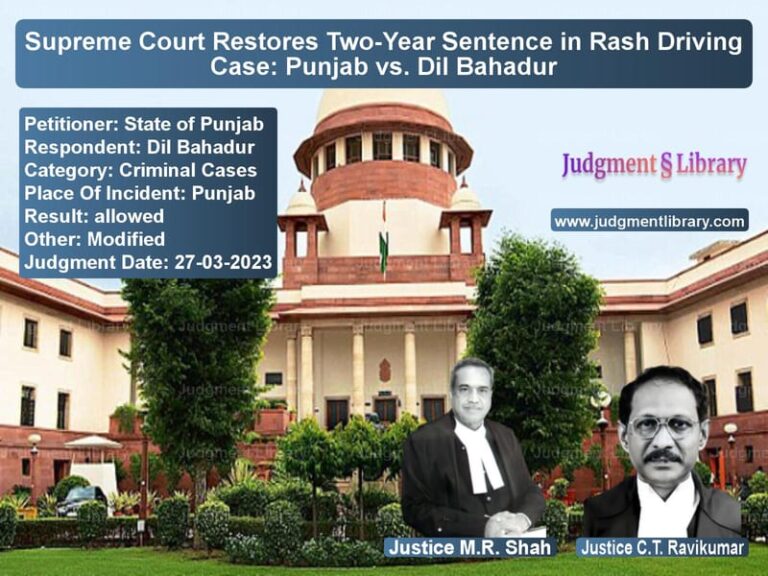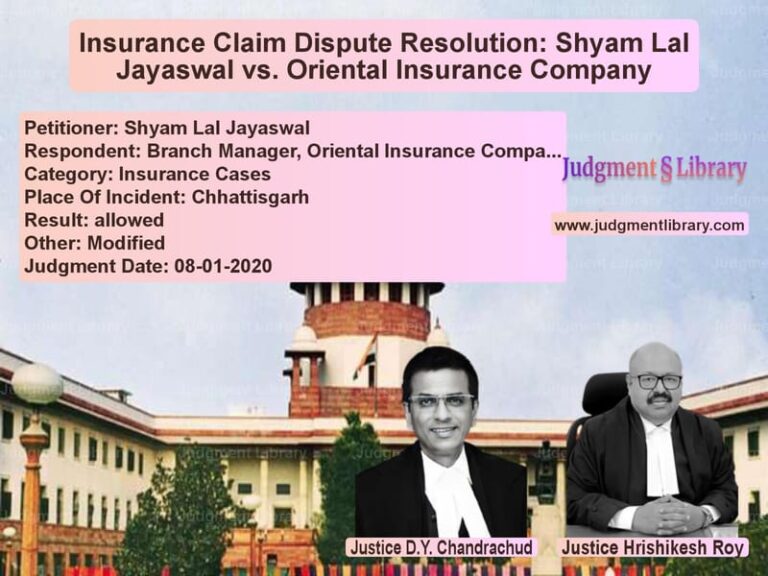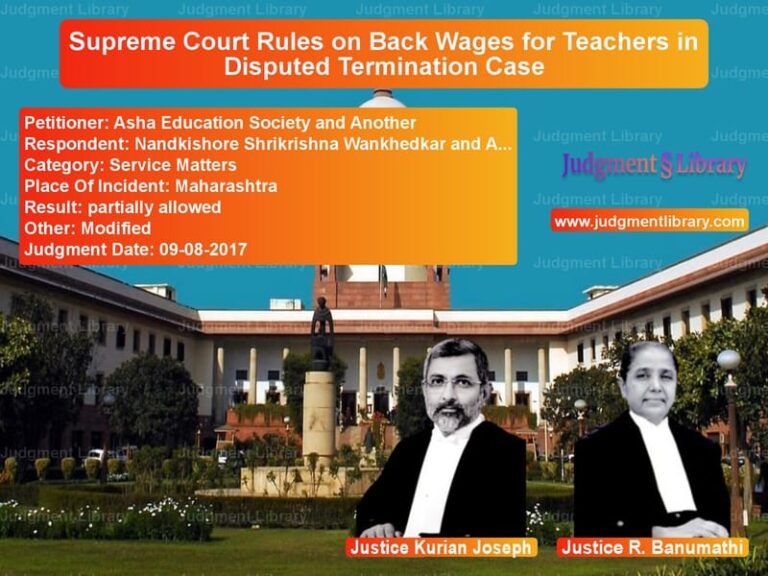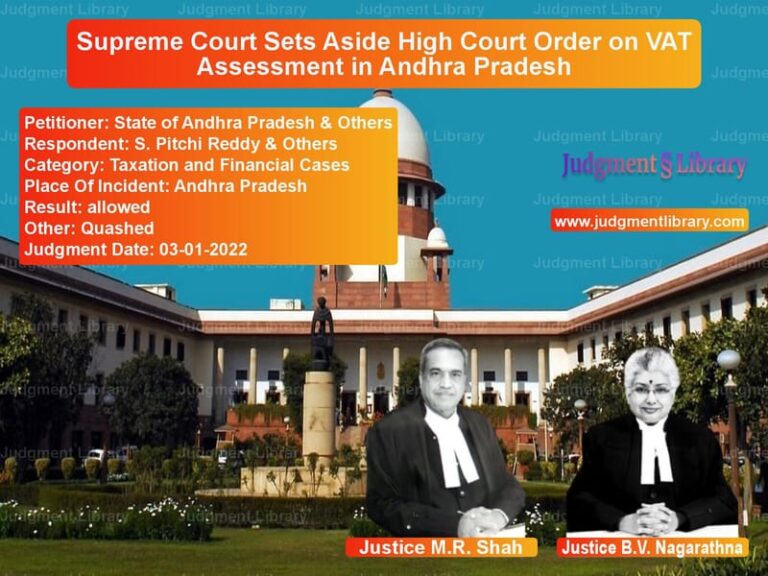Supreme Court Upholds Murder Conviction: Manjit Singh and Others Found Guilty Under IPC 302
The Supreme Court of India recently delivered a significant ruling in the case of Manjit Singh v. The State of Punjab, where it upheld the murder conviction of multiple individuals involved in a violent attack that led to the death of Dalip Singh. The judgment, delivered by Justices A.M. Khanwilkar and Dinesh Maheshwari, reaffirmed the principles of unlawful assembly and constructive liability under Section 149 of the Indian Penal Code (IPC).
Background of the Case
The case revolved around a violent assault on March 3, 2001, in the Barnala Court Complex, Punjab. The victims—Dalip Singh, Rajinder Pal Singh, Gurnam Singh, and Beant Singh—were attacked by a group of individuals, including Manjit Singh, Labh Singh, Avtar Singh, Bakhtaur Singh, and Sukhwinder Singh. The attack was reportedly triggered by a longstanding enmity between the two factions.
During the attack, Dalip Singh suffered multiple injuries, including a severe head wound inflicted by a ghop (sharp weapon), which later led to his death on March 12, 2001. The prosecution charged the accused under various sections of the IPC, including Sections 148 (rioting with deadly weapons), 302/149 (murder in furtherance of common object), 323, 324, and 326.
Arguments of the Appellants
The appellants, Manjit Singh and Sukhwinder Singh, raised the following key arguments:
- Their conviction was based on unreliable evidence, particularly the statements of injured witnesses Rajinder Pal Singh (PW-5) and Gurnam Singh (PW-6).
- There was no direct evidence linking Manjit Singh to the actual act of murder.
- Manjit Singh was not present at the crime scene, and his alibi was supported by multiple defense witnesses.
- The case against Sukhwinder Singh was weak as he allegedly caused only minor injuries.
- The prosecution failed to establish the presence of a common object under Section 149 IPC.
Arguments of the Respondent (State of Punjab)
The prosecution, representing the State of Punjab, presented the following arguments:
- The attack was premeditated, and all accused persons were actively involved.
- Manjit Singh was not only present at the scene but also instigated the attack by exhorting the others to take revenge.
- Medical reports confirmed that the deceased had suffered fatal injuries due to the attack.
- All the accused were armed with deadly weapons and participated in a coordinated attack.
- The plea of alibi raised by Manjit Singh was an afterthought and was not supported by credible evidence.
Supreme Court’s Analysis
1. Role of Injured Eye-Witnesses
The Supreme Court upheld the credibility of PW-5 and PW-6, emphasizing that injured witnesses provide the most reliable testimony. The Court noted:
“The presence of injured witnesses at the scene is beyond doubt. Their testimony is consistent, supported by medical evidence, and free from major contradictions.”
2. Common Object Under Section 149 IPC
The Court analyzed the application of Section 149 IPC, which deals with constructive liability. It ruled that all accused shared a common object of attacking and causing harm to the victims. The judgment stated:
“The accused persons formed an unlawful assembly, armed themselves with deadly weapons, and executed a pre-planned attack. Each member of the assembly is liable for the consequences.”
3. Rejection of Manjit Singh’s Alibi
Manjit Singh’s claim that he was at a different location at the time of the attack was rejected. The Court pointed out that:
“The plea of alibi was not raised at the initial stage, nor was it substantiated by reliable evidence. The defense witnesses appeared to be coached and unreliable.”
4. Conviction Based on Reliable Evidence
The Court found that the evidence against the accused was overwhelming. It observed:
“The prosecution has established beyond reasonable doubt that the accused actively participated in the attack. The death of Dalip Singh resulted directly from the injuries inflicted by the accused.”
Final Judgment
The Supreme Court upheld the convictions and sentences of the accused. The judgment concluded:
“The appellants, having been part of an unlawful assembly with a clear intent to cause harm, are guilty under Section 302/149 IPC. Their conviction is upheld, and they shall serve their respective sentences.”
The Court directed the appellants to surrender within four weeks to serve the remaining part of their sentence.
Implications of the Judgment
This ruling reinforces several important legal principles:
- Testimonies of injured witnesses carry significant evidentiary value.
- Section 149 IPC imposes liability on all members of an unlawful assembly.
- Pleas of alibi must be raised early and substantiated with credible evidence.
- The presence of a common object is a crucial factor in group assault cases.
The Supreme Court’s decision underscores the importance of holding all participants in an unlawful assembly accountable for their actions.
Petitioner Name: Manjit Singh & Anr..Respondent Name: State of Punjab.Judgment By: Justice A.M. Khanwilkar, Justice Dinesh Maheshwari.Place Of Incident: Barnala, Punjab.Judgment Date: 03-09-2019.
Don’t miss out on the full details! Download the complete judgment in PDF format below and gain valuable insights instantly!
Download Judgment: Manjit Singh & Anr. vs State of Punjab Supreme Court of India Judgment Dated 03-09-2019.pdf
Direct Downlaod Judgment: Direct downlaod this Judgment
See all petitions in Murder Cases
See all petitions in Bail and Anticipatory Bail
See all petitions in Judgment by A M Khanwilkar
See all petitions in Judgment by Dinesh Maheshwari
See all petitions in dismissed
See all petitions in supreme court of India judgments September 2019
See all petitions in 2019 judgments
See all posts in Criminal Cases Category
See all allowed petitions in Criminal Cases Category
See all Dismissed petitions in Criminal Cases Category
See all partially allowed petitions in Criminal Cases Category







